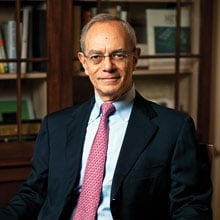From the President: MIT Artist on a Global Stage
Joan Jonas represents United States at Venice Biennale.
We are used to the idea that from time to time, someone from MIT receives a highly impressive academic prize—for example, one awarded in December in Stockholm. But this spring, MIT is being recognized in a different realm, in a different European city: at the 56th Venice Biennale, the most prestigious contemporary art event in the world, Joan Jonas, professor emerita in MIT’s program in Art, Culture, and Technology, will be the single artist officially representing the United States. Curated by the director of the MIT List Visual Arts Center, Paul C. Ha, her new installation will occupy all of the U.S. Pavilion’s five galleries.

The scale of the honor is no surprise: in the field of contemporary art, Professor Jonas, who joined the MIT faculty in 1998, is a giant. Trained as a sculptor, she pioneered the field of performance art and was one of the first to incorporate video technology, using it as both a means of expression and a subject of her commentary. Boldly experimental, she plays with the possibilities of new technologies and explores their effect on culture and nature in ways that feel very MIT.
Professor Jonas started her career in the early 1970s, just as MIT began to make a serious commitment to the visual and performing arts under the leadership of its then president, Jerry Wiesner. An electrical engineer with a passion for music and sculpture, Jerry saw vital connections among the “communications” he studied as an engineer, the means of communication between human beings (including media, music, and art), and what Norbert Wiener called cybernetics, or “the scientific study of control and communication in the animal and the machine.”
As we celebrate Joan Jonas’s accomplishments, we see Jerry Wiesner’s vision in full bloom.
Editor’s note: Joan Jonas’s work will be on view in Venice at the U.S. Pavilion from May 9 through November 22. The MIT List Visual Arts Center’s exhibition “Joan Jonas: Selected Films and Videos 1972–2005” runs through July 5.
Keep Reading
Most Popular
Large language models can do jaw-dropping things. But nobody knows exactly why.
And that's a problem. Figuring it out is one of the biggest scientific puzzles of our time and a crucial step towards controlling more powerful future models.
The problem with plug-in hybrids? Their drivers.
Plug-in hybrids are often sold as a transition to EVs, but new data from Europe shows we’re still underestimating the emissions they produce.
How scientists traced a mysterious covid case back to six toilets
When wastewater surveillance turns into a hunt for a single infected individual, the ethics get tricky.
Google DeepMind’s new generative model makes Super Mario–like games from scratch
Genie learns how to control games by watching hours and hours of video. It could help train next-gen robots too.
Stay connected
Get the latest updates from
MIT Technology Review
Discover special offers, top stories, upcoming events, and more.